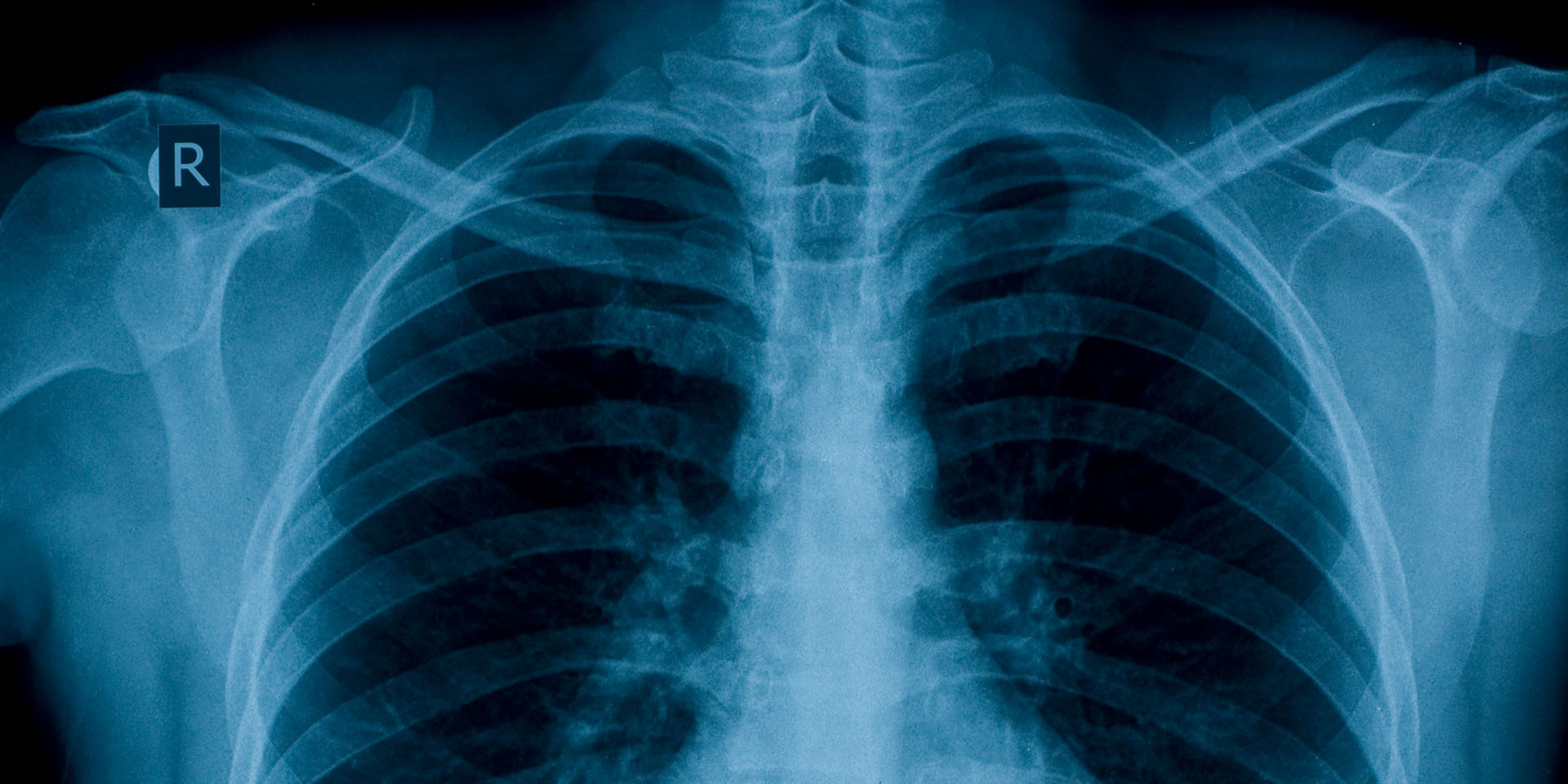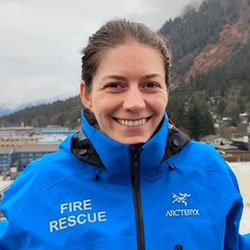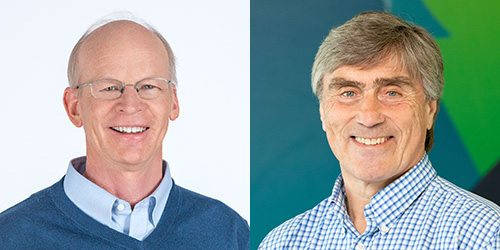Publication Q&A: Monoclonal Antibodies Derived from B Cells in Subjects with Cystic Fibrosis Reduce Pseudomonas Aeruginosa Burden
Published
Featured Researchers

June 9, 2025 – Recent research led by Seattle Children’s Research Institute and the University of Washington explores how harnessing patients’ own immune cells can help develop targeted monoclonal antibodies against Pseudomonas infections, opening new potential avenues for treatment and prevention.
What are Pseudomonas aeruginosa, and why are they a concern?
Pseudomonas aeruginosa bacteria are a serious threat to human health worldwide, causing severe infections, especially in those with serious conditions like cystic fibrosis (CF). They are increasingly resistant to many antibiotics.
What are monoclonal antibodies (mAbs), and why are they important in treating infections?
 Malika Hale, on a University of Washington School of Medicine clinical rotation in Juneau, Alaska.
Malika Hale, on a University of Washington School of Medicine clinical rotation in Juneau, Alaska.Monoclonal antibodies (mAbs) are a promising alternative or novel addition to antibiotics for treating Pseudomonas infections. Researchers from Seattle Children’s Research Institute and the University of Washington recently shared promising results from a study using B cells from people with CF to craft monoclonal antibodies to fight lung infections.
Produced by the immune system’s B cells, monoclonal antibodies are tiny molecules designed to recognize and neutralize germs. This process starts with an initial exposure to the disease-causing pathogen, which allows the body to learn how to produce the antibodies against the target. As a result, a dedicated population of B cells, called memory B cells, carry the genetic sequences necessary to ultimately produce pathogen-specific antibodies.
Successful monoclonal therapies, such as the ones developed for COVID-19, typically rely on human sequences from individuals who have recovered from infection. Seattle Children’s Research Institute’s Malika Hale, a University of Washington MD-PhD student in the Medical Scientist Training Program and part of the Rawlings Lab in the Center for Immunity and Immunotherapies, and colleagues sought to design new mAbs for Pseudomonas using a similar approach.
Having physician-scientists like Dr. Rawlings and Dr. Gibson — and the infrastructure that supports them — is a huge strength of Seattle Children’s.
— Malika Hale, Rawlings Lab
How did the researchers develop these antibodies for Pseudomonas?
This study was a clinical-research collaboration among Seattle Children’s Cystic Fibrosis Research Program in the research institute’s Center for Respiratory Biology and Therapeutics, and two immunology labs: the University of Washington’s Pepper Lab and the research institute’s Rawlings Lab.
To isolate human Pseudomonas-specific immune memory B cells, the researchers turned to blood samples from people with CF seen for clinic visits. CF is a genetic disorder that primarily affects the lungs and digestive system, leading to thick, sticky mucus production that can cause severe respiratory and nutritional issues. People with CF frequently experience Pseudomonas lung infections that are long-lasting and difficult to eliminate.
Having collected the genetic sequences that help generate mAbs against Pseudomonas in these individuals, the research team was able to create human antibodies that could strongly bind to Pseudomonas aeruginosa bacteria and effectively treat animals infected with these bacteria in a preclinical model. While further investigation is needed, these findings may help develop new and more effective therapies against these life-threatening bacteria.
What role did Team Science at Seattle Children’s play in this work?
 Drs. David Rawlings (left) and Ron Gibson
Drs. David Rawlings (left) and Ron GibsonA critical one. “None of this work would’ve been possible without Dr. Ron Gibson and Sharon McNamara as members of the Clinical Core of our CF Research Program, and the rest of the team at Children’s Cystic Fibrosis Clinic,” Hale said. The Clinical Core is supported by a Cystic Fibrosis Foundation Research Development Program award to facilitate translational (bedside-to-bench) research. “They made the logistical parts very easy, explaining the study to eligible patients who were there for a regular CF visit and collecting the blood sample if they were interested in participating.
“Having physician-scientists like Dr. Rawlings and Dr. Gibson — and the infrastructure that supports them — is a huge strength of Seattle Children’s. The CF clinicians helped us understand what would be impactful for patients, and both teams brought knowledge of clinical and scientific logistics,” Hale said. “When you're in the research world, you spend a lot of time reading other people's papers and there’s agreement about the big questions in the field. But in clinic, there are other questions not as frequently articulated in the literature, but ones that clinicians see all the time. I'm hopeful we're at the stage of increasing integration of those two areas.”
How is this study a first?
We previously developed highly efficient methods to discover specific protective antibodies that could be used as medicines to treat COVID-19 and malaria, but this study is among the first to apply them to Pseudomonas. It also adds to the limited knowledge about the adaptive immune response to Pseudomonas in an especially vulnerable population.
Can you describe the anti-Pseudomonas antibodies development process?
Our general approach is to look for the memory B cells that can recognize some important protein on the pathogen of interest. As our target in this study, we looked for memory B cells that can bind a toxin-related protein on the surface of Pseudomonas called PcrV.
Memory B cells are rare cells — the product of an intricate process in lymph nodes and other tissues that allows for preservation of instructions for making potentially protective antibodies even after the infection has been cleared. We chose to look for these cells from blood donors with CF, because Pseudomonas infections are unusually common — and unusually dangerous — in this population.
Once we found the rare, PcrV-binding memory B cells, we extracted their unique B cell receptor (BCR) sequences one by one. In publishing our new paper, we made more than 150 of these sequences available for other researchers. To test whether the BCR sequences could be used to make antibody medicines, we picked about a dozen of the sequences and made each of them into a single, pure antibody in the lab. Almost all of our mAbs could bind PcrV, and some did so very strongly.
What did the tests show about these new antibodies?
We tested five of our new anti-PcrV mAbs in a preclinical model with Pseudomonas pneumonia and found that four were able to dramatically reduce the bacteria in the lungs. In fact, they performed at least as well as our benchmark antibody, made from a commercial drug candidate called gremubamab that has been used in clinical trials. This was especially notable because gremubamab was the product of multiple rounds of antibody engineering, while our mAbs were copied directly from the BCRs in human B cells, without any additional optimization.
Besides developing new mAbs and more than doubling the number of available BCR sequences, we did not limit our search to one subset (called an isotype) of memory B cells. In this study, some of our best antibodies came from cells that would have been filtered out if we had only looked at the most commonly studied IgG isotype.
There is a lot more work to do to understand what this means for Pseudomonas. However, interestingly, our earlier work in COVID-19 and malaria has shown unexpected importance of the IgM isotype in protection from infection through immune memory.
How can anti-Pseudomonas mAbs lead to better ways to treat or prevent treat or prevent infections?
Patient populations who might benefit from a mAb against Pseudomonas include people with hospital-associated pneumonias. These infections can be deadly despite antibiotic treatment.
Additionally, although new treatments for CF have dramatically improved and extended life for many, Pseudomonas infections are still a real threat to children and adults living with CF, and once established, they can be nearly impossible to clear. For this high-risk population, an anti-Pseudomonas mAb could be added to standard antibiotic treatment, or even be given prophylactically to high-risk kids with CF who are not infected, to help prevent Pseudomonas infections before they can start. These potential new treatment options will require more clinical research.
What are the next steps and long-term goals for this Pseudomonas research?
Based on how well they controlled lung infections in preclinical models, several of our new anti-Pseudomonas mAbs are promising candidates to one day treat or prevent infections in humans. It is important that our antibodies were built using blueprints found in human immune cells. Unlike traditional approaches to antibody discovery, which start with small-animal model sequences, the mAbs we developed for this study do not need additional engineering to “humanize” them before they could be offered in a clinical trial. However, we will need funding to support moving these specific antibodies forward to pursue a human clinical study.
The Rawlings’ and James’ labs are engineering plasma cells to be living factories for therapeutic proteins. One of many future applications could be providing a steady supply of protective anti-Pseudomonas mAbs to children with CF.
We are constantly working to optimize our methods for efficiently obtaining accurate BCR sequences from individual memory B cells, which can be technically challenging. We hope to publish a detailed write-up of our protocol that could be helpful to other researchers attempting single-cell BCR sequencing for memory B cells of any specificity.
Children’s contributing authors: Malika Hale (co-first author), Christopher Thouvenel, Andrea Repele, David Rawlings, MD (co-corresponding author), all of the Rawlings Lab; and the Cystic Fibrosis Research Program’s Sharon McNamara, RN, MN, and Ron Gibson, MD, PhD, Center for Respiratory Biology and Therapeutics.
University of Washington School of Medicine collaborators: Kennidy Takehara (co-first author), Pepper Lab, and Marion Pepper, PhD (co-corresponding author), associate professor and chair of the Department of Immunology.
This research was funded by the National Institutes of Health, Cystic Fibrosis Foundation and Seattle Children's Foundation (Tom Hansen Investigator for Pediatric Innovation Endowment).
Read this article in eLife (version of record published online April 24, 2025).


